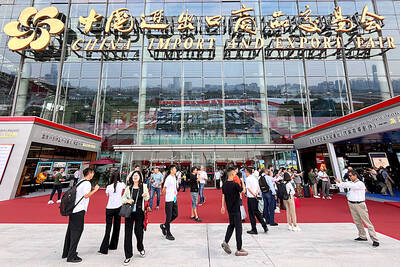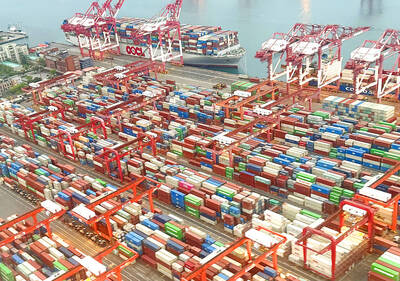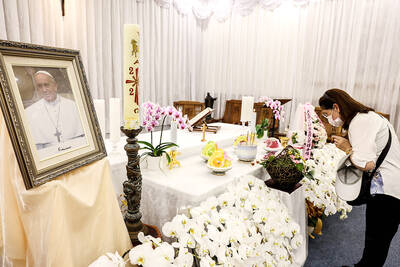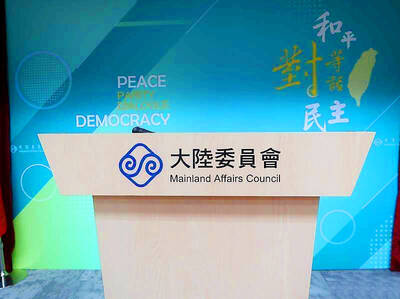It's not an obvious place for a fighter jet factory: a sleepy town in a country at peace for almost 200 years that is better known for making safe cars (Volvos) and do-it-yourself furniture (Ikea).
Yet on the gleaming production floors of the Saab aircraft plant in Linkoeping, a two-hour train ride southwest of Stockholm, one of the world's most advanced combat planes is being assembled.

PHOTO: AP
Three years after securing its first export sale, to South Africa, the sleek, single-engine JAS 39 Gripen now competes aggressively against the vaunted US-made F16.
NATO member Hungary recently picked the Gripen over the F16, and a deal with the Czech Republic awaits parliamentary confirmation. Poland and Austria are expected to pick a fighter this year and the Swedish fighter is in the running.
The Gripen, which means griffin, the mythological monster, "is the newest aircraft available in the light to middleweight fighter category," says John Neilson, spokesman for Saab-BAE Systems, the Anglo-Swedish company that markets the plane. ``Its operational capability is far greater than any of its competitors.''
Patrolling above lonely Scandinavian forests and lakes, the Gripen has never fired a shot in anger. But some military experts rate its performance as roughly comparable to the combat-tested F16, used in 23 air forces worldwide.
"It's close," said David North, editor in chief of Aviation Week & Space Technology and a former US Navy pilot who has flown both planes. The Gripen makes up for shorter range and lower top speed, he noted, with an advanced data-link system that allows pilots to relay images to each other and to ground controllers without switching on their own radar.
"They're very similar," agreed Paul Jackson, editor of Jane's All the World's Aircraft.
The Gripen's big obstacle is not agility or firepower, but rather Sweden's neutrality, he said. What if a buyer needs more planes or spare parts in a hurry?
"Is the Swedish government going to say, `No, we won't supply you with material if you're in a war'? That's something anybody buying Swedish material has to think about," Jackson said.
Defense Minister Bjoern von Sydow dismissed these concerns. "This is defense equipment and it should be able to be used," he said.
Although Sweden last did battle in 1814, in the Napoleonic Wars, and stayed out of the two world wars, the nation of 9 million people has a powerful arms industry. The home of Ericsson cellphones, Electrolux refrigerators and Alfred Nobel's dynamite also makes Bofors howitzers and Celsius submarines.
Previous fighters, including the Draken (dragon) and Viggen (thunderbolt), were made almost exclusively for the Swedish military. But when the Cold War ended, the air force cut a planned Gripen order of 300 planes to 204 and Saab scrambled to market its planes abroad.
"We hadn't been very interested in selling. But to keep the skill level in the country we have to sell," said former air force chief Kent Harrskog. "Otherwise, they would have to shut down."
After overcoming steering problems that caused a few spectacular crashes, notably at a 1993 air show over downtown Stockholm, Saab teamed up with British defense giant BAE Systems in 1995. Gripens now have in-air refueling capability and NATO encrypted radio and instruments.
With a price tag of about US$35 million to US$40 million, which defense experts say is slightly more than the F16 but less than the French Mirage 2000, the Gripen is finding a niche as a lightweight, multirole fighter.
The continuously upgraded F16 remains the main competitor, and more modern fighters are on the horizon: the French Rafale; the Eurofighter, made by a consortium of European companies; and the American Joint Strike Fighter.
In 1999, South Africa ordered 28 Gripens to be delivered starting in 2006.
Hungary signed a lease for 14 used aircraft late last year. The Czech government wants 24 new planes.
The orders are relatively small compared with the more than 4,000 F16s sold abroad. But Sweden went to great lengths to secure the deals.
Contracts include generous "offset" agreements that commit Swedish investment sometimes greater than the purchase price of the planes. That's not uncommon in international aircraft sales, but Sweden's enticements startled some competitors.
"We're starting to realize that this is an offset-based competition rather than an aircraft competition," William Perkins, spokesman for F16 maker Lockheed-Martin, said.
He said it's hard to beat the F16, which proved itself in the 1991 Gulf War, Kosovo and Afghanistan.
"Hungary selecting the Gripen has caused us some concern in central Europe," Perkins said. "Is it going to affect the rest of the world? I don't think so."
Saab-BAE Systems is marketing the Gripen in Brazil and Australia and is testing the terrain in India, Malaysia and the Philippines.

CARROT AND STICK: While unrelenting in its military threats, China attracted nearly 40,000 Taiwanese to over 400 business events last year Nearly 40,000 Taiwanese last year joined industry events in China, such as conferences and trade fairs, supported by the Chinese government, a study showed yesterday, as Beijing ramps up a charm offensive toward Taipei alongside military pressure. China has long taken a carrot-and-stick approach to Taiwan, threatening it with the prospect of military action while reaching out to those it believes are amenable to Beijing’s point of view. Taiwanese security officials are wary of what they see as Beijing’s influence campaigns to sway public opinion after Taipei and Beijing gradually resumed travel links halted by the COVID-19 pandemic, but the scale of

TRADE: A mandatory declaration of origin for manufactured goods bound for the US is to take effect on May 7 to block China from exploiting Taiwan’s trade channels All products manufactured in Taiwan and exported to the US must include a signed declaration of origin starting on May 7, the Bureau of Foreign Trade announced yesterday. US President Donald Trump on April 2 imposed a 32 percent tariff on imports from Taiwan, but one week later announced a 90-day pause on its implementation. However, a universal 10 percent tariff was immediately applied to most imports from around the world. On April 12, the Trump administration further exempted computers, smartphones and semiconductors from the new tariffs. In response, President William Lai’s (賴清德) administration has introduced a series of countermeasures to support affected

Pope Francis is be laid to rest on Saturday after lying in state for three days in St Peter’s Basilica, where the faithful are expected to flock to pay their respects to history’s first Latin American pontiff. The cardinals met yesterday in the Vatican’s synod hall to chart the next steps before a conclave begins to choose Francis’ successor, as condolences poured in from around the world. According to current norms, the conclave must begin between May 5 and 10. The cardinals set the funeral for Saturday at 10am in St Peter’s Square, to be celebrated by the dean of the College

CROSS-STRAIT: The vast majority of Taiwanese support maintaining the ‘status quo,’ while concern is rising about Beijing’s influence operations More than eight out of 10 Taiwanese reject Beijing’s “one country, two systems” framework for cross-strait relations, according to a survey released by the Mainland Affairs Council (MAC) on Thursday. The MAC’s latest quarterly survey found that 84.4 percent of respondents opposed Beijing’s “one country, two systems” formula for handling cross-strait relations — a figure consistent with past polling. Over the past three years, opposition to the framework has remained high, ranging from a low of 83.6 percent in April 2023 to a peak of 89.6 percent in April last year. In the most recent poll, 82.5 percent also rejected China’s